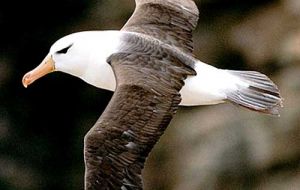MercoPress. South Atlantic News Agency
Falkland Islands black-browed albatross no longer endangered, says ACAP
 The Black-browed albatross has been classified as endangered since 2003 in the IUCN Red List.
The Black-browed albatross has been classified as endangered since 2003 in the IUCN Red List. The conservation status of the Falkland Islands Black-browed albatross could be down listed from endangered based on ground and aerial surveys carried out in 2010, ACAP* Coordinator Anton Wolfaardt reported to the Falklands’ Environmental Committee.
Falklands Conservation’s Chief Executive Officer James Fenton said: “All recent surveys indicate the Falkland Islands population of black-browed albatrosses is increasing, which indicates the species is no longer endangered. As we host the largest populations in the world this is especially good news. The significant reduction in the number of birds caught as a by-catch of the fishing industry in recent years illustrates how wildlife conservation benefits from everyone working together”.
An application will be made to the International Union for Conservation of Nature (IUCN) to down-list the Black-browed albatross globally.
An assessment of the population trends and conservation status of Black-browed Albatrosses in the Falkland Islands, led by Mr Wolfaardt, has backed up reports based on aerial surveys by Ian and Georgina Strange carried out in 2011, that the population was on the increase.
The Black-browed albatross has been classified as endangered since 2003 in the IUCN Red List.
The endangered threat status, which indicated that the species faced a high risk of extinction in the wild, was applicable to the global population. With approximately 70% of the global population breeding in the Falklands, the status of that population has significant bearing on the global conservation status of the species.
Mr Wolfaardt plans to submit the findings to relevant periodicals once further work has been carried out on the data. Some estimates may change slightly, but not significantly, he told the committee.
Environment Committee member Sally Poncet agreed the findings were indeed a good news story for the Falklands, but added that numbers were still going down in South Georgia.
Mr Wolfaardt, explained the most recent archipelago wide surveys of Black-browed albatrosses breeding in the Falkland Islands were conducted in 2010, five years after the previous census.
He said different methods, principally aerial and ground-based had been used independently to census the population in the Falklands. Previously these census initiatives had reported contrasting population trends.
The aerial based surveys indicated an increase in the population between 1986 and 2005 and the ground based surveys a decline between 2000 and 2005, and using historical data an inferred decline between 1995 and 2005.
However, the aerial and ground-based surveys conducted in 2010 both revealed an increase in the Black-browed albatross population of at least 4% per annum between 2005 and 2010.
Current estimates for the annual breeding population in the Falkland Islands range between 475, 500 and 535,000 breeding pairs.
The exact reasons for the increase are not entirely clear, but efforts to reduce seabird by-catch and favourable feeding conditions are likely to have contributed, said Mr Wolfaardt.
He added: “Efforts should also continue to further improve seabird by-catch mitigation, both to buffer the local population against possible future changes, and to improve the conservation status of other populations and species.”
Trawlers pose the biggest risk to the Black-browed albatross although the introduction of tori lines in 2004 bought an estimated 90% reduction in fatalities.
While long lining claims fewer birds this has also been further reduced with improved mitigation measures. (Penguin News).
(*) Agreement on the Conservation of Albatross and Petrels - is a multilateral agreement which seeks to conserve albatrosses and petrels by coordinating international activity to mitigate known threats to their populations. ACAP currently has 13 member countries and covers 30 species of albatross, petrels and shearwaters.


![“Working directly with President [Donald] Trump and Congress, we accomplished what no one else could,” Patel stressed](/data/cache/noticias/108417/130x80/fbi.jpg)

Top Comments
Disclaimer & comment rules-

-

-

Read all commentsUnlike The Argentine President. :)
Jul 24th, 2012 - 04:54 pm 0...or British jobs. ;)
Jul 24th, 2012 - 06:36 pm 0must have stopped migrating to rgenweener
Jul 24th, 2012 - 07:19 pm 0Commenting for this story is now closed.
If you have a Facebook account, become a fan and comment on our Facebook Page!